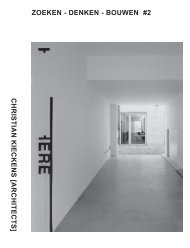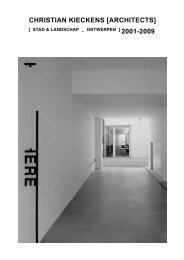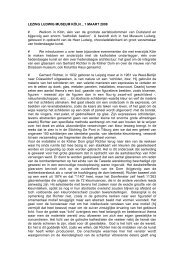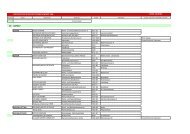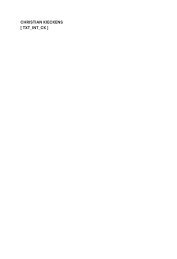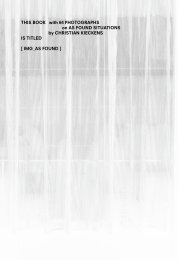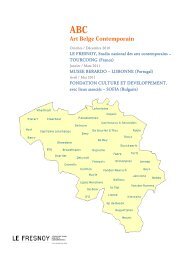03.03 > 07.03.2008 - Christian Kieckens Architects
03.03 > 07.03.2008 - Christian Kieckens Architects
03.03 > 07.03.2008 - Christian Kieckens Architects
You also want an ePaper? Increase the reach of your titles
YUMPU automatically turns print PDFs into web optimized ePapers that Google loves.
Nikolaus HIRSCH<br />
Philipp MISSELWITZ<br />
Aleksandra JAESCHKE<br />
Andrea DI STEFANO<br />
_ Nikolaus HIRSCH (Frankfurt) has taught at the AA in London, and at UPenn in<br />
Philadelphia. His work includes the Dresden Synagogue,Bockenheimer Depot<br />
Theater (with choreographer William Forsythe), „Soundchambers“ for Museu<br />
Serralves in Porto, and the Hinzert Document Center. Current projects include<br />
Unitednationsplaza in Berlin, an art laboratory in Delhi and the European<br />
Kunsthalle. Curated „ErsatzStadt” at Volksbühne Berlin and is member of the<br />
“Curating Architecture” program at Goldsmiths College in London.<br />
_ Philipp MISSELWITZ, architect and curator (Berlin and Istanbul) has taught at<br />
the University of North London, the AA and the University of the Arts Berlin.<br />
Initiated the project ‘Geographies of Conflict’ which led to the publication “City of<br />
Collision – Jerusalem and the Principles of Conflict Urbanism”. Leading the<br />
research project ‘Spaces of Production’ on behalf of the European Kunsthalle<br />
Cologne. Curatorial activities include “Shrinking Cities” and “Liminal Spaces”,<br />
conferences in Ramallah, Jerusalem and Tel Aviv and an exhibition in Leipzig.<br />
_ Aleksandra JAESCHKE, °1976 Poland. Co-founder of studio AION and the Italian<br />
branch of the research & design network OCEAN. Studied Graphic Design and<br />
Architecture, graduating from the AA in 2005. Worked in the UK, Spain and Italy.<br />
In her work, she focuses on processes of formation leading towards novel models<br />
of material organisation and investigating the essential relationship between<br />
structural and functional performance across scales and domains.<br />
_ Andrea DI STEFANO, °1973 Italy. Architect, critic and curator. Studied History and<br />
Theory of Architecture at IUAV in Venice and graduated from the AA in 2005.<br />
Co-founded the AION architectural studio and the Italian node of OCEAN.<br />
Collaborated with the New York-based design studio biothing. Organized<br />
workshops and curated exhibitions, including the Architectural Section of the<br />
Prague Biennial in 2003.<br />
Corps Exquisite<br />
On the basis of their model for the European Kunsthalle (www.eukunsthalle.<br />
com) Nikolaus Hirsch and Philipp Misselwitz will investigate the potentials of<br />
a growing, accumulative art institution. The workshop will act as a laboratory<br />
that plans a collective structure consisting of individual components. It<br />
results in a network of possible spatial options stemming from programmatic<br />
modules and leads to numerous possible spatial configurations. Traditionally<br />
an art institution’s plan, with its exhibition spaces, offices, storage facilities,<br />
restrooms, auditorium, café etc., forms a coherent entity that is designed by<br />
a single author. The new strategy breaks from this assumption and divides<br />
the space into autonomous yet related components.<br />
The project follows the hypothesis that the permanent negotiation between<br />
stability and instability is not seen as a problem or deviation from an ideal<br />
condition, but instead considered as a chance to develop a new typology<br />
of art institution: a growing site that acknowledges the change of artistic,<br />
social and economic conditions, using them as a point of departure for its<br />
architectural strategy.<br />
The time-based, growing art institution is comparable with the logic of<br />
“Corps Exquisite”: a procedure by which an image or a story emerges<br />
from the collective putting-together of individual segments. The result is a<br />
network of possible paths starting from a beginning and branching out in a<br />
number of different directions.<br />
10<br />
The Matter of Intimacy<br />
One day I went to a factory producing socks and tights to ask them whether<br />
they could make a light shade for me. We don’t make light shades they<br />
answered. And I said: you’ll see that you will! (Bruno Munari)<br />
Like material fetishists, we will dive into the intimate materiality of socks<br />
and tights to let them express their latent desires. Oscillating between<br />
architecture and fashion we will unravel the sex appeal of the inorganic.<br />
Through soft models and hard diagrams we will sample across variations in<br />
membranes behaviour in order to abstract emerging performative patterns<br />
and develop trans-scalar structural prototypes.<br />
sampling: The process of taking a sample of a signal at evenly spaced<br />
intervals of time in order to convert an analog signal into a digital<br />
representation.<br />
1.<br />
2.<br />
3.<br />
The graduate, Mike Nichols, 1967<br />
Falkland Lamp, Bruno Munari, 1964<br />
Patterned hosiery<br />
11



